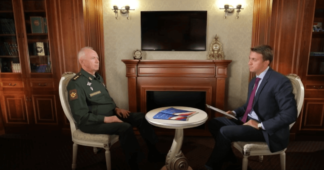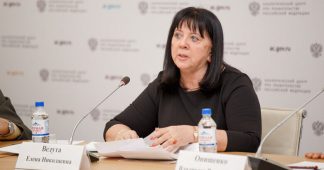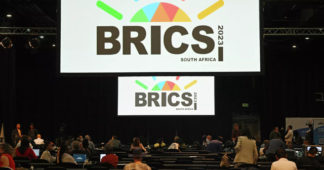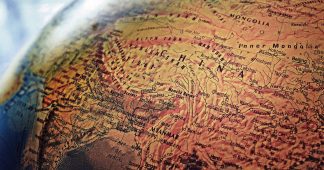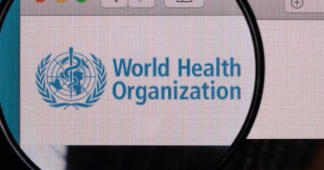A sign of the imminent demise of the neocolonial world-system
By Charles McKelvey
8 Aug 2023
In the neocolonial world-system, there are a significant number of global development agencies, including UN-related organizations and agencies, humanitarian aid agencies, big national development agencies, global health organizations, and major foundations. The function of the global development agencies is to give a degree of legitimacy to the neocolonial world order. They do this by ameliorating the most barbarous inhumane conditions that are a consequence of the structures and functioning of the neocolonial world-system, and by creating an image of systemic attention to eliminating poverty and to improving the material conditions of the poor of the world. And they do it by channeling the energies of young people with convictions and concerns in relation to world poverty, channeling their careers in a direction that is functional for maintaining the neocolonial world order. But most of all, they do it by distracting attention away from the Third World revolutionary leaders and movements of the past 100 years, whose proposals for an alternative more just world order are marginalized by an endless stream of words written by development agency bureaucrats and experts.
The fundamental difference between the development agency experts and the Third World revolutionaries turns on their approaches to the issue of power. Both the experts and the revolutionaries speak of the empowerment of the people, and both are aware of the need for money to attain objectives. But they have entirely different and opposed prioritizing with respect to the question of power.
The experts and bureaucrats begin with the formulation of a project plan, and then go to donor agencies in the quest for financing. With money in hand, giving them influence among the people, they go to the poor and enlist their participation. Of course, the influence of the poor on the objectives and strategies of the project is limited, given their powerlessness and their inclusion only after important questions have been asked, in spite of the “bottom-up” language of the project.
In contrast, the revolutionaries begin with the formulation of principles and concrete proposals. They call upon the people to join a political and social movement for the taking of political power, with the intention that after the taking of control of key institutions of the state, the revolution in power would be able to implement the proposals, with the backing of the people. As the revolution in power sees the need for external financing for some of its projects, it appeals to investors and foundations of the rich countries for support of projects that the revolution and the people have defined. The revolution seeks aid without conditions, seeing the aid as correcting for unfair global economic structures and as compensating for past injustices, and/or as required by the moral principles of international solidarity and cooperation among nations and peoples.
In short, bureaucrats seek money from the rich in order to finance projects that they hope will improve living conditions and will empower the poor. In contrast, revolutions seek power first, on the basis of a visionary proposal that wins over the people; and then they negotiate support from the wealthy from a position of political power.
Nina Munk’s 2013 book, The Idealist: Jeffery Sachs and the Quest to End Poverty, is in part a review of the career of the world renowned economist Jeffery Sachs, whose proposals I reviewed in two commentaries last week (“Building a new American economy: A critique of the analysis of Jeffrey D. Sachs,” August 1, 2023; “Beyond subtle Eurocentrism: A critique of the foreign policy assumptions of Jeffrey Sachs,” August 4, 2023). But Munk’s book is also a fascinating introduction to the subculture of the global development agencies. I have occasionally come across the world of development agencies in my own journey as an academic tied to Third World revolutionary movements. Munk’s excellent portrayal, written in a journalistic style, brings to light certain prevailing practices, which make clearer the function of the global development agencies in maintaining the neocolonial world-system.
Sachs became interested in poverty in Africa in 1995, when he traveled to Sub-Saharan Africa for the first time, accepting an invitation to visit Zambia. Africa at that time was being ravaged by AIDS, tuberculosis, and malaria epidemics, as health care systems, chronically underfunded, had collapsed. What Sachs saw, Munk writes, offended his sense of human decency, which moved him to a change of heart with respect to his earlier faith in the power of open markets, free trade, deregulation, privatization, and fiscal discipline. He threw himself into the study of world poverty, but not, it should be noted, a study of the speeches and writings of Third World revolutionaries, who during the course of the twentieth century had addressed in political practice the issue of poverty in their countries, attaining significant gains in some cases.
For Sachs, it became of question of how to break the so-called “poverty trap,” which was established by the interconnected burdens of disease, illiteracy, high fertility rate, dismal agricultural productivity, lack of capital, weak or non-existent infrastructure, debt, hunger, drought, and malnutrition. Sachs concluded that there needed to be a big push in foreign aid, which would lift countries out of poverty once and for all. Sachs’ plan called for investments in fertilizer, high-yield hybrid seeds, and irrigation in order to double or triple agricultural production; the building of a basic health care system and universal primary education; the construction of an infrastructure of safe water, electricity, and roads; the building of manufacturing centers; the identification and development of export markets; and attracting tourists. He maintained that the costs of this investment were very low for the advanced economies, and they would have long term payoffs.
Munk focuses on two of the villages that Sachs established as “Millennium Villages.” The first was Dertu in Kenya’s North Eastern Province, where ethnic Somalis, traditionally a nomadic people with cattle and camel herds, settled in the wake of the destructive consequences of wars, drought, famines, and floods. In Dertu, they were able to survive on the free distribution of food and other needs by humanitarian agencies. The Millennium Villages Project plan was expressed in a 147-page single-space document written by twenty-nine academics, mostly from Columbia University, featuring dozens of charts, tables, timelines, and hopeful objectives.
Ahmed Mohamed was hired by the Millennium Villages Project to direct the project in Dertu. Ahmed was the son of an illiterate Somali nomadic pastoralist. Ahmed’s father had three wives and twenty-one children, and he had once possessed large herds of cattle and camels but had become impoverished as a result of war and draught. Ahmed was able to obtain an education through odd jobs and scholarships, eventually obtaining a B.Sc. degree in forestry in Kenya and a Ph.D. in Agriculture in Belgium.
Munk writes that the Millennium Villages Project in Dertu unintentionally encouraged pastoralists to permanently abandon their nomadic life for settlement in the town. As a result of the project, significant material improvements had been made, but the people had become dependent on the humanitarian agencies and had not become self-sufficient, as had been the plan. Munk writes, “Month after month, accustomed to the ritual by this time, people lined up for rations from the UN: a four-liter tin of cooking oil, enriched porridge for the children, bags of rice and cornmeal.” Some locals maintained a second residence in one of the nearby refugee camps, where they received additional food aid and essential goods—tarps, charcoal, blankets, and so on. Ahmed declared: “Our people have refugee syndrome. There are so many handouts here. Free food, free medications, free water, free education. And now we come in and talk to them about empowerment.”
In Ahmed’s view, “Pastoralism is the only real future for us—all other paths are domed to failure.” He arrived to believe that the problems of the Somali people of northeastern Kenya could only be resolved by accepting the natural order and the traditional nomadic way of life of the region but enabling it to become self-sufficient through diversifying its economy with such activities as leather tanning, livestock trading, and large-scale milk production, which would link Dertu to the regional and global economy. Ahmed, however, never would have the opportunity to develop and implement these ideas.
Progress was made in Dertu during its implementation of the Millennium Villages Project. More than 200 houses had acquired iron sheet roofs, and the village was attracting refugees from the war in Somalia because of its relative wealth. Traveling salesmen were hawking small items. Three restaurants, a pharmacy, a hardware store, and a dormitory for lodging had been opened. However, after three and a half years and $2.5 million, Dertu still had no running water, electricity, or paved roads; nor did it have industry or long-term jobs. The once wide-open pastoral landscape had been turned into something resembling a shantytown. Community latrines were clogged and overflowing; the garbage committee had ceased to function.
Many Dertu residents arrived to the conclusion that the Millennium project had not delivered on its promises, which had been made on the assumption of self-sustained economic growth. Permanent houses and a secondary school had not been built, and there was no support for people to start businesses. The road remained impassible during the rainy season. One of Dertu’s more prominent citizens, owner of the pharmacy, wrote a letter of grievances with fourteen points to the district’s Member of Parliament. The letter maintained that the Project has created dependence syndrome; and that there was no sense of ownership of the project and no planning by the community. Munk writes that “A profound pessimism had settled in over the entire Millennium Villages Project.”
Sachs contracted David Siriri in 2007 to launch the Millennium Villages Project in Ruhiira, an isolated village in the highlands of southwestern Uganda. Siriri was from a family of middle-class background in rural Uganda. David’s father was a primary school mathematics teacher and his mother was a midwife at a local hospital, and the family owned twenty acres of land, on which the family—which included eight children—grew millet, cassava, soybeans, sweet potatoes, and kidney beans for family consumption. They also cultivated some cotton as a cash crop. However, the family fell into extreme poverty when the economy of Uganda collapsed, with inflation that made David’s father’s school teaching salary almost worthless, and when David’s mother suffered a debilitating stroke at the age of 28, forcing the family to sell off their land acre by acre.
David was able to attend primary and secondary school through the sponsorship by a family via the Christian Children’s Fund, an American charity. He attended the one university in Uganda, the esteemed Makerere University, which was free to those who could pass its rigorous entrance exam. He lived frugally at the university and worked on the weekends, enabling him to send to his family nearly all the money awarded to him for living expenses, including school fees for his younger siblings. At Makerere, David obtained a B.Sc. degree in agriculture and a master’s degree at its World Agroforestry Center. He subsequently obtained a Commonwealth Scholarship to attend the University of Nottingham in the United Kingdom, where he obtained a Ph.D. in agroforestry, working in a restaurant six nights a week to send money home to his family and to support his own family, by then consisting of a wife and daughter.
In accepting the position with the Millennium Villages Project, Siriri was most impressed by the project’s deep pockets and its plan to spend $120 million to end poverty in dozens of villages in Africa. Nonetheless, Siriri was from the outset concerned by ambiguities in his job description. After spending a week in an orientation workshop in Nairobi, Kenya, he became aware that the objectives were clear, but it was less clear how the objectives were to be achieved.
Munk’s description of the meeting between Sachs and the President of Uganda, Yoweri Museveni, revealed the disconnect of the Millennium Villages Project from the political process in Uganda. The President listened to Sachs’ appeal for the support of the President for the project, in which one gets the impression that Sachs wanted the government of Uganda to finance roads and electricity for Ruhiira, thus signaling the President’s support for the project. As the meeting concluded, the President stated, “But there are other things to consider, Professor. You know, in these countries of Africa, we have many other problems. This is not India or China. There are not markets. There is not network. No rails. No roads. We have no political cohesion.” One gets the impression that the President was trying to politely and respectfully tell Sachs that the project was idealistic, unworkable in the political-economic and social context of Uganda.
It happens that southern Ugandans do not like corn, which they dismiss as “school food” or “prison food.” Nevertheless, Sachs and his staff in New York decided that corn would be the best crop for the Millennium villages, because it is nutritious, drought-tolerant, and relatively easy to grow. It can be eaten fresh, or dried and ground into cornmeal. Therefore, in September 2006, Siriri dutifully distributed 32 tons of high-yield maize seeds and 222 tons of fertilizer to more than 7,000 households in Ruhiira. The entire cost was paid by the Millennium Villages Project. At harvest time in February 2007, the results were excellent. Maize yields had increased from 1.8 tons per hectare to 3.7 tons, resulting in a bumper crop of 3,840 tons of maize. The villagers were well fed, and they had excess maize that in theory could be sold locally or stored for lean years. However, there were serious problems with the theory in practice. There were no storage facilities to protect the surplus maize from vermin, pests, and disease. The maize was stored everywhere, in living rooms and kitchens, and the rats were everywhere as well, eating their way through bags of maize. At the same time, due to the remoteness of the village, there were neither roads nor trucks to link farmers to markets. Doing what poor farmers in remote regions always have done with bumper crops, they dumped their excess maize on the local market all at once, with the result that market prices collapsed. Most farmers were forced to sell their maize at prices that were far less than the cost of seed and fertilizers; others, unable to find buyers at any price, left the maize to rot. Siriri managed to find buyers in neighboring Rwanda at a price that was 35% above the break-even point, but it was only for fifty tons, a fraction of the total yield for the growing season. The villagers were unhappy. They asked, why grow a crop you do not like to eat and that is hard to sell?
Thus, it could be seen in retrospect that the money spent on maize seeds and fertilizers was wasted, and that improving Ruhiira’s agricultural prospects involved more than simply increasing crop yield. Every intervention had consequences, which had to be anticipated in the plan, which must include the construction of storage facilities to store surplus crops, the construction of roads and access to trucks to link farmers to market, and the availability of local and regional markets that would provide a good market for surplus products.
The insufficient shifting of gears
The initial plan was for a big investment in agricultural outputs, providing free fertilizers and high-yield hybrid seeds. As the farmers became increasingly self-sufficient, the subsidies for the agricultural inputs would be reduced, and they would be eliminated in five years.
As unintended problems emerged, adjustments were made. The expected time of project self-sufficiency was expanded from five to ten years, and a market approach to donations was undertaken, seeking a larger number of smaller donors rather than a few high net-worth individual donors.
When these adjustments did not resolve the financial shortfall, a more fundamental shift in strategy was undertaken in 2008. The project was reconceptualized as small-holder commercial agriculture, or supplementary commercial cooperative agriculture, with initial investments provided not by aid donors but by capitalist investors. This turn to high-value crops required infrastructure investments in irrigation, small dams, refrigeration, storage, paved roads, and electricity, which were to be funded by loans or equity investments, and not by aid grants. The loans were to be repaid on the basis of the rising income of the small-hold farmers, who also would be in a position to begin to fund local education and health. Possible export crops included ground cardamon, pineapple, cocoa, palm oil, chicken eggs, and ginger.
The turn coincided with a change of fashion with respect to African development, in which business was seen as the solution to Africa’s problems. The new approach severed the connection between the elimination of poverty and foreign aid.
However, the proposal had low-cost effectiveness, as a result of the increasing costs of fertilizer and the considerable investments needed for overcoming the weak infrastructure. New projects came up against the hard realities of the increasing cost of fertilizer and animal feed, poor roads, insufficient water, the lack of export market ties, and low local prices. For these reasons, investments were insufficient.
For a very good review, written in 2019, on Munk’s book on Sachs, see “The Not-So-Great Professor: Jeffrey Sachs’ Incredible Failure to Eradicate Poverty in Africa.”
We remind our readers that publication of articles on our site does not mean that we agree with what is written. Our policy is to publish anything which we consider of interest, so as to assist our readers in forming their opinions. Sometimes we even publish articles with which we totally disagree, since we believe it is important for our readers to be informed on as wide a spectrum of views as possible.

